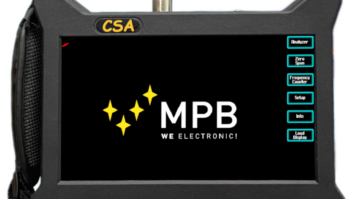
WASHINGTON — President Donald Trump is lighting a fire under federal agency’s in an effort to free up more government spectrum for advanced communications, including calling for a National Spectrum Strategy by the third quarter of next year.
That came in a presidential memorandum to the heads of executive departments and agencies Thursday under the heading “Developing a Sustainable Spectrum Strategy for America’s Future.” It contained a bunch of action items, though mostly reports and studies and a Spectrum Strategy Task Force.
The President made clear that with the burgeoning need for spectrum for industry, the government has to make a concerted to free up more of its spectrum, including to make sure America wins in 5G. “Federal agencies must thoughtfully consider whether and how their spectrum-dependent mission needs might be met more efficiently and effectively, including through new technology and ingenuity,” he wrote.
On the issue of freeing up spectrum, the President is on the same page as Hill Republicans and Democrats, as well as his FCC chair, Ajit Pai.
“American companies and institutions rely heavily on high-speed wireless connections, with increasing demands on both speed and capacity,” the memorandum read. “Wireless technologies are helping to bring broadband to rural, unserved, and underserved parts of America. Spectrum-dependent systems also are indispensable to the performance of many important United States Government missions. And as a Nation, our dependence on these airwaves is likely to continue to grow.”
“While American industry continues to extract greater and greater value from spectrum, each technological leap also increases demands on its usage. Those demands have never been greater than today, with the advent of autonomous vehicles and precision agriculture, the expansion of commercial space operations, and the burgeoning Internet of Things signaling a nearly insatiable demand for spectrum access. Moreover, it is imperative that America be first in fifth-generation (5G) wireless technologies — wireless technologies capable of meeting the high-capacity, low-latency, and high-speed requirements that can unleash innovation broadly across diverse sectors of the economy and the public sector. Flexible, predictable spectrum access by the United States Government will help ensure that Federal users can meet current and future mission requirements for a broad range of both communications- and non-communications-based systems.”
The action items were:
- Within 180 days, those agencies and departments, working with the National Telecommunications & Information Administration, the President’s chief telecom policy adviser, have to report to the Secretary of Commerce (NTIA is under Commerce) on their future spectrum requirements as well as on a review of their current frequency assignments and usage. The secretary may release a summary of the report, but is not required to.
- Within 180 days, the Office of Science and Technology Policy (OSTP) “shall submit a report to the President on emerging technologies and their expected impact on non-Federal spectrum demand” and “a report to the President on recommendations for research and development priorities that advance spectrum access and efficiency.”
- Within 180 days, and annually after that, Commerce, working with the FCC and other agencies, must submit a report, that will be made public “to the extent practicable,” on “the status of existing efforts and planned near- to mid-term spectrum repurposing initiatives.”
- Within 270 days, Commerce, against working with the FCC and others, shall submit to the President, through the Director of the National Economic Council and the Assistant to the President for National Security Affairs, a long-term National Spectrum Strategy that includes legislative, regulatory, or other policy recommendations.”
The goal of that strategy include to:
- “increase spectrum access for all users, including on a shared basis, through transparency of spectrum use and improved cooperation and collaboration between Federal and non-Federal spectrum stakeholders;
- “create flexible models for spectrum management, including standards, incentives, and enforcement mechanisms that promote efficient and effective spectrum use, including flexible-use spectrum licenses, while accounting for critical safety and security concerns;
- “use ongoing research, development, testing, and evaluation to develop advanced technologies, innovative spectrum-utilization methods, and spectrum-sharing tools and techniques that increase spectrum access, efficiency, and effectiveness;
- “build a secure, automated capability to facilitate assessments of spectrum use and expedite coordination of shared access among Federal and non-Federal spectrum stakeholders; and
- “improve the global competitiveness of United States terrestrial and space-related industries and augment the mission capabilities of Federal entities through spectrum policies, domestic regulations, and leadership in international forums.”
The spectrum strategy task force will be co-chaired by the nation’s CTO and director of the National Economic Council (or their appointee) and will need to include representatives of OMB, OSTP, the National Security Council, the National Space Council, and the Council of Economic Advisers, in consultation with the FCC.
Cable operators are in search of more spectrum for unlicensed WI-FI and potentially their own licensed mobile wireless businesses, so NCTA-the Internet & Television Association was pleased as well.
“We welcome the Presidential Memorandum calling for the development of a comprehensive, long-term national spectrum strategy,” the trade group said. “Spectrum has become one of the most critical inputs for the communications and information technologies that are driving America’s economic growth. The services that rely on unlicensed spectrum alone generated more than $525 billion in value for the U.S. economy in 2017. We look forward to engaging in constructive dialogue with the White House, NTIA, and the FCC on the development of a balanced national spectrum policy that will meet the growing need for both licensed and unlicensed spectrum to support next-generation wireless technologies.”
“We commend the administration for recognizing the importance of establishing a national spectrum strategy,” said CTIA President Meredith Attwell Baker. “With the right approach based on licensed wireless spectrum, America’s wireless carriers will invest hundreds of billions of dollars and create millions of jobs to deploy next-generation networks and win the global 5G race.”
Public Knowledge praised the President’s initiative. “The President’s Memorandum is a pragmatic, common sense approach to developing a sustainable spectrum policy to guarantee our wireless future that maintains American leadership while continuing to meet our public safety and national security needs,” asid SVP Harold Feld. “We particularly applaud the president for embracing the need for a balanced approach that facilitates new technologies for sharing spectrum between federal and non-federal users. We look forward to working with the newly established Spectrum Task Force to develop a National Spectrum Policy that promotes competition and ensures the benefits of the public airwaves for all Americans.”












